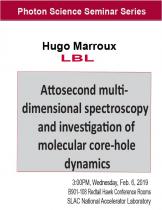SLAC, 901-108 Redtail Hawk Conference Rooms
Speaker: Hugo Marroux
Program Description:
The recent development of non-linear spectroscopy in the extreme ultraviolet (XUV) with attosecond time resolution creates the possibility to investigate high energy excited states with unprecedent accuracy. Using attosecond pulses generated by high harmonic generation combined with few cycle NIR pulses, our laboratory was able to generate four-wave mixing signal in atomic species. This advance permits the use of fully optical techniques, such as multidimensional spectroscopy, to probe excited state dynamics located at XUV energies. Due to the broadband pulses used in these experiments, four wave mixing signal is dominated by interaction pathway interferences and yields information on multiple states (wavepacket), inhibiting the measurement of single state dynamics. By combining this four wave-mixing technique with pulse shaping, multidimensional spectroscopy in the XUV with attosecond pulses is demonstrated. The additional frequency dimension allows for the separation of different interaction pathways and retrieves single state dynamics. Importantly, the apparatus exhibits sub-10 meV energy resolution while conserving the few-cycle time resolution of an attosecond experiment.
At higher photon energy, attosecond transient absorption spectroscopy (ATAS) is employed to probe core excited states of molecules. The lifetime of the iodine atom’s 4d core excited state is probed in various molecular species. Due to ligand field effects, 4d core levels are split in each spin orbit state, separating core levels in energy based on their orientations relative to the molecular axis. In ICl, we show that the lifetime of the state varies between 6.5 and 3.5 fs depending on the orientation of the core-hole and its spin orbit states. The decay mechanism of these excited states will be discussed in terms of Auger decay localized on the iodine atom and electron/energy transfer with nearby Cl atom. This time resolved experiment is the first to observe differences in core-excited state dynamics due to core-hole orientation and provides a route towards the investigation of core-excited states in molecular species in the time-domain.





